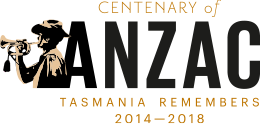- Home
- About
-
History
- Timeline
- Shared stories
- Share your story
- Armistice Centenary
- Tasmania’s Victoria Cross Legacy
- Women and war
- Tasmanian Aboriginal soldiers
- Did you know?
- Caring for military memorabilia, medals and photos
- A guide to preserving Tasmania's war heritage
- 40th Battalion
- 12th Australian Infantry Battalion
- Royal Australian Air Force
- Royal Australian Navy
- Battle of the Somme
- War and sport
- Activities
- Grants and Programs
- News
- Contact
- Home
- About
-
History
- Timeline
- Shared stories
- Share your story
- Armistice Centenary
- Tasmania’s Victoria Cross Legacy
- Women and war
- Tasmanian Aboriginal soldiers
- Did you know?
- Caring for military memorabilia, medals and photos
- A guide to preserving Tasmania's war heritage
- 40th Battalion
- 12th Australian Infantry Battalion
- Royal Australian Air Force
- Royal Australian Navy
- Battle of the Somme
- War and sport
-
Activities
- Calendar of events
- Dig for the Diggers - one act play
- ANZAC Day
- Launch of Tasmania’s Centenary of ANZAC Commemorations
- Remembrance Day
- 10,000 Steps Challenge
- Hartzview marks World War One
- Australian Living Memorials
- Journey Across the Strait
- Lone Pine seedlings
- How Tasmanians commemorated the Centenary
- The Odd Angry Shot
- Grants and Programs
-
News
- Newsletters
- Australian War Dogs
- Students travel to Gallipoli
- ANZACs Remembered – Commemorative Medallion
- ANZAC Day 2021 - Light up the Dawn
- Anzac Day 2021
- A valuable archive of over 130 operational maps
- Ecumenical Church Service
- Simpson Prize
- Our Victoria Cross Heroes book launch
- Nominations open for Tasmanian Honour Roll of Women
- Remembering South Hobart people who served
- Vintage Peace Postcard from 1916 Reprinted
- Sites of Significance Then and Now
- Commemorative Medallion for Second World War veterans
- Victory in Pacific 75th Anniversary
- Public consultation sought for Terms of Reference on Royal Commission
- Contact
- Timeline
- Shared stories
- Share your story
- Armistice Centenary
- Tasmania’s Victoria Cross Legacy
- Women and war
- Tasmanian Aboriginal soldiers
- Did you know?
- Caring for military memorabilia, medals and photos
- A guide to preserving Tasmania's war heritage
- 40th Battalion
- 12th Australian Infantry Battalion
- Royal Australian Air Force
- Royal Australian Navy
- Battle of the Somme
- War and sport
Women and World War I

Seven members of the Australian Army Nursing Service (AANS) in Launceston, Tasmania, 1917. Photo was possibly taken shortly before the nurses sailed on the transport ship SS Mooltan for service in the Middle East including Salonica, Greece. Staff nurse Sister Laura Grubb is on the far right. Australian War Memorial image P02198.001
During World War One, women served at home and abroad.
The war provided an opportunity for some women to travel and serve overseas.
Nearly 3 000 Australian women enlisted in World War One and served as nurses who cared for the wounded, wrote to patients’ families, and in some cases, were given added responsibilities and opportunities to be trained in other areas of medical care such as anesthetics.
Some women felt compelled to venture to the war front to help. Launceston-born Ettie Rout went to Egypt and the Western Front to promote health and safe sex.
The home front
Back in Australia, women “kept the home fires burning”, managed the household and raised the children in the absence of the menfolk.
World War One mobilised women and consequently volunteerism emerged, with women filling roles normally conducted by men. Women invested a lot of emotional labour in the war effort by caring for the troops and sending comforts to the war front. They knitted vests, mufflers, mittens and socks; packed parcels; wrote letters; and became involved in fundraising for armaments and ambulances.
Ideological battles
War prompted some women to become politically active. The conscription debate divided Australian society in World War One. Many women actively campaigned for conscription while others promoted peace. War continued to divide women in Australia in the 1960s and 1970s, with many women participating in the anti-Vietnam war protests.
Women have also had a role to play in encouraging men to enlist. Women participated in enlistment marches to encourage men to enlist in World War One. Some resorted to sending white feathers to men as symbol of cowardice for not enlisting.
Loss and mourning
The death toll from the war left many women to mourn sons, brothers, husbands, fiancés, friends and community members.
Other women welcomed male family members home, only to find the men who returned were not necessarily the same men -- physically and mentally -- who had gone to war.
Reference
Women’s Mobilisation for War (Australia) by Rae Frances International Encyclopedia of the First World War 1914-1918 Online.



